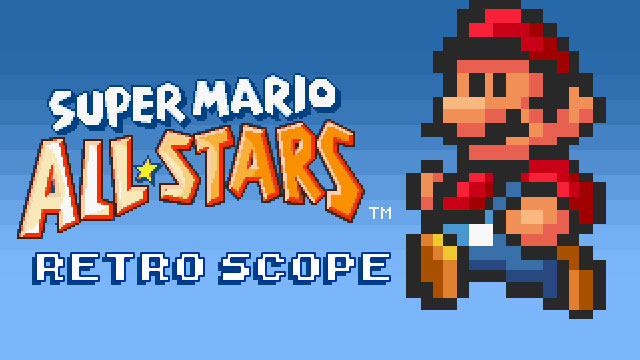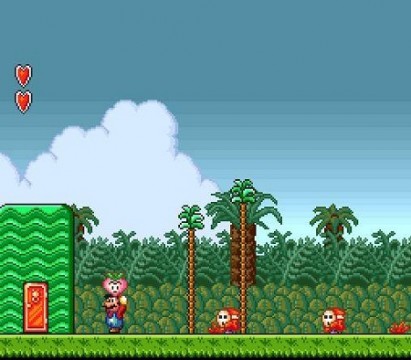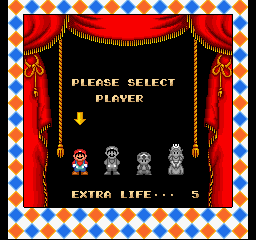
Super Mario All-Stars is practically the best game since games were a thing. It has the entire Super Mario Bros. series on it, it’s in the most evocative visual style ever– 16-bit– and it manages to upgrade what was already considered the pinnacle of gaming in its time. However, there is one game in particular that stands out above the rest, and rightfully so: Super Mario Bros. 2 USA. It’s an entirely different game that didn’t even begin its life as a Mario title, but eventually developed into a game that some consider the best in the series.
Starting from the beginning, Super Mario Bros. 2 was originally released as Yume Kōjō: Doki Doki Panic, only co-developed by Nintendo alongside Fuji to promote Yume Kojō ’87. As the name should suggest, the event and game were originally planned to be exclusively released in Japan. Plans started to shift shortly thereafter. When Nintendo released the original Super Mario Bros. 2 (known as Super Mario Bros.: The Lost Levels in the US), the game was deemed too hard for American audiences. This put Nintendo in a tough place as it couldn’t simply avoid the biggest market it had by not giving them the sequel to its now best-selling game. The solution was to simply re-skin a game it had previously released for a niche subset of people and call it Mario.
While this plan seemed foolish then, it profited for Nintendo in tremendous ways. Not only was the game incredibly well-received in America, but the Japanese audience who had a chance to play the game demanded that it be released in Japan as well– and it was. Japan saw the game as Super Mario Bros. 2 USA and it went on to sell beyond measure.

Super Mario Bros. 2 proved to be one of the most innovative titles in a sense that ironically challenges itself. It featured the ability to swap characters between Luigi, Toad, Peach, and, of course, Mario, each with varying abilities. Luigi was able to jump higher, but he floated along with the “wind” while Mario saw himself being a smooth mix of all attributes. With Super Mario Bros. 2 being the pinnacle of Mario gaming at its time, it had also found itself in tragic position of introducing figures we’d only see once or twice in the future. For example, the main bad guy in this game isn’t Bowser, but a giant frog named Wart. Wart wouldn’t show his face for years on end after that aside from a cameo appearance in The Legend of Zelda: Link’s Awakening. With the game being almost an exclusively unique title within the series, it’s to be expected that some characters would be swept under the rug in order to maintain a seemingly organized look for Super Mario’s franchise.
One thing that made the game special above others is that it takes a very vague approach to the Metroidvania style of platformers. The game doesn’t necessary utilize the same type of movements or level progression, but it laid to rest the idea that moving right was all you had to do in order to beat the game. In Super Mario Bros., you saw yourself consistently going right, jumping at the correct moments and only exploring that route of gameplay. It was launched early on in the NES days during the revitalization of gaming altogether, so it’s not a fault of the game’s design, but to see such a drastic, innovative shift in a game’s direct sequel is something that doesn’t often occur.

Being able to switch characters also presented itself as a new mechanic that not even Sega could pick upon until its Genesis system. With each character having his or her own ways of being controlled, you often saw Mario run through levels utilizing the mechanics most closely found in the first Super Mario Bros. However, by giving Luigi a higher, floatier jump, Toad a heavier set and higher speed, and Peach a longer jump, you saw people playing the game differently throughout. It was small, but it showcased how each character had real use beyond being members of a story that could have remained the same for decades. Even then, the game gave us power jumping, climbing up vines, accessing portions of levels that only existed in clouds, and bosses that eclipsed simply jumping over Bowser by giving each of them their own specific gimmick and strategy.
Even beyond the simple character selection, it opened up a new narrative thread where Peach isn’t captured, Goombas aren’t the main enemies, and the overall theme of the game doesn’t rotate around jumping on characters, but throwing them. Super Mario Bros. 2 created a new game within an older one. The old mechanics that were found in the first title were kicked to the sideline in favor of a play style that challenged people to play an iconic series in a different light. Not only that, but the character that you traversed eight castles in the first game to rescue was now one that could be chosen as the hero. The character who told you the princess was captured could even be chosen. Player One could choose the guy who was destined to be Player Two. Nintendo rebirthed an older game that was made for promotional purposes into a new game with new life simply by re-skinning it and working around what would have been labeled as a barrier. Only here is it ever witnessed that a game can have life as one thing entirely, be painted over with classic characters, and create an identity of its own that transcends the franchise it’s inspired by.
Super Mario Bros. 2 revolutionized the genre that Mario had already been king of all while being a different game entirely. People caught on to this and realized that having a game that really took off in a different lane brought life into the series. It’s only a true wonder why Nintendo hasn’t revisited the game style much in later games and only gave it a small nod in Super Mario World. The game wasn’t made to be a Mario title– everyone knows that– but what it became is so much more.




 ShareThis
ShareThis







I don’t know if it stands out compared to other Mario titles, but it is unique. I liked it then and it’s still good now, though the revolutionary game is really Mario64. Now that stands out. As far as the 16-bit titles, I would go with Super Mario World 2. That was the pinnacle.
I have to add Mario 2 kind of reminds me of Zelda 2. Both games took a unique approach and really nothing like that has been tried by Nintendo since that I can think of, with maybe the Mario Galaxy series being an exception.
I agree with you there. The game is definitely unique, but it’s one that I have always struggled to enjoy.
I usually stayed away from it when I played All Stars, probably because it was so different to the other Mario Bros. games. I love how so many parts of it stuck with the Mario series though – like Lugi’s jump, Shy Guys and Birdo! It’s definitely a game worth sampling.
Two was my go to game cause when it came out there was nothing but the first Mario to compare it to and this one had more characters to choose from, more enemies, stranger level design and the ability to fly for a short while with Peach not to mention a more adventurous feel than before. It wasn’t until later I learned it was skinned on another game but by then I had already enjoyed it.